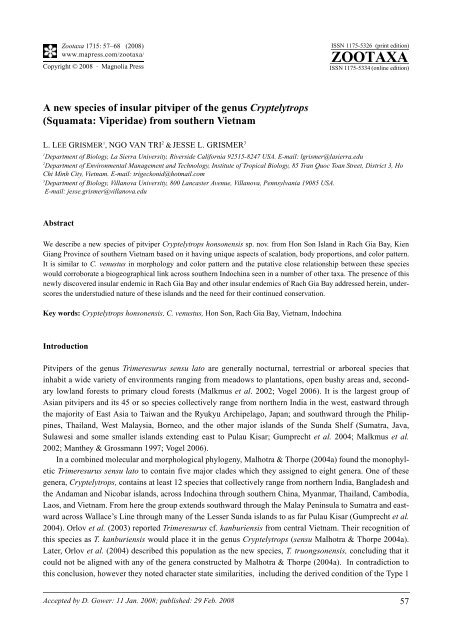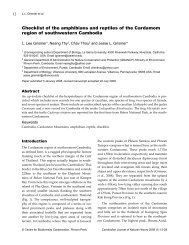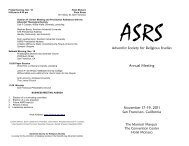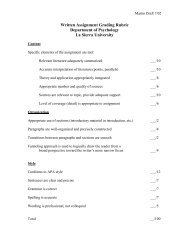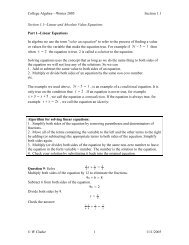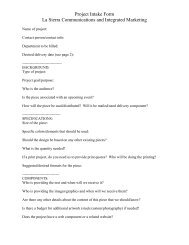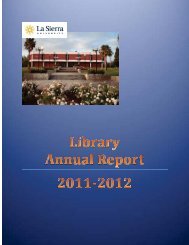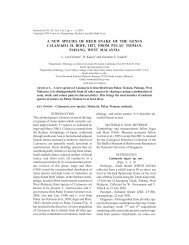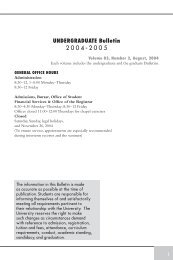Zootaxa, A new species of insular pitviper of the genus Cryptelytrops ...
Zootaxa, A new species of insular pitviper of the genus Cryptelytrops ...
Zootaxa, A new species of insular pitviper of the genus Cryptelytrops ...
You also want an ePaper? Increase the reach of your titles
YUMPU automatically turns print PDFs into web optimized ePapers that Google loves.
TERM OF USE<br />
This pdf is provided by Magnolia Press for private/research use.<br />
Commercial sale or deposition in a public library or website site is prohibited.<br />
<strong>Zootaxa</strong> 1715: 57–68 (2008)<br />
www.mapress.com/zootaxa/<br />
Copyright © 2008 · Magnolia Press<br />
ISSN 1175-5326 (print edition)<br />
ZOOTAXA<br />
ISSN 1175-5334 (online edition)<br />
A <strong>new</strong> <strong>species</strong> <strong>of</strong> <strong>insular</strong> <strong>pitviper</strong> <strong>of</strong> <strong>the</strong> <strong>genus</strong> <strong>Cryptelytrops</strong><br />
(Squamata: Viperidae) from sou<strong>the</strong>rn Vietnam<br />
L. LEE GRISMER 1 , NGO VAN TRI 2 & JESSE L. GRISMER 3<br />
1<br />
Department <strong>of</strong> Biology, La Sierra University, Riverside California 92515-8247 USA. E-mail: lgrismer@lasierra.edu<br />
2<br />
Department <strong>of</strong> Environmental Management and Technology, Institute <strong>of</strong> Tropical Biology, 85 Tran Quoc Toan Street, District 3, Ho<br />
Chi Minh City, Vietnam. E-mail: trigeckonid@hotmail.com<br />
3<br />
Department <strong>of</strong> Biology, Villanova University, 800 Lancaster Avenue, Villanova, Pennsylvania 19085 USA.<br />
E-mail: jesse.grismer@villanova.edu<br />
Abstract<br />
We describe a <strong>new</strong> <strong>species</strong> <strong>of</strong> <strong>pitviper</strong> <strong>Cryptelytrops</strong> honsonensis sp. nov. from Hon Son Island in Rach Gia Bay, Kien<br />
Giang Province <strong>of</strong> sou<strong>the</strong>rn Vietnam based on it having unique aspects <strong>of</strong> scalation, body proportions, and color pattern.<br />
It is similar to C. venustus in morphology and color pattern and <strong>the</strong> putative close relationship between <strong>the</strong>se <strong>species</strong><br />
would corroborate a biogeographical link across sou<strong>the</strong>rn Indochina seen in a number <strong>of</strong> o<strong>the</strong>r taxa. The presence <strong>of</strong> this<br />
<strong>new</strong>ly discovered <strong>insular</strong> endemic in Rach Gia Bay and o<strong>the</strong>r <strong>insular</strong> endemics <strong>of</strong> Rach Gia Bay addressed herein, underscores<br />
<strong>the</strong> understudied nature <strong>of</strong> <strong>the</strong>se islands and <strong>the</strong> need for <strong>the</strong>ir continued conservation.<br />
Key words: <strong>Cryptelytrops</strong> honsonensis, C. venustus, Hon Son, Rach Gia Bay, Vietnam, Indochina<br />
Introduction<br />
Pitvipers <strong>of</strong> <strong>the</strong> <strong>genus</strong> Trimeresurus sensu lato are generally nocturnal, terrestrial or arboreal <strong>species</strong> that<br />
inhabit a wide variety <strong>of</strong> environments ranging from meadows to plantations, open bushy areas and, secondary<br />
lowland forests to primary cloud forests (Malkmus et al. 2002; Vogel 2006). It is <strong>the</strong> largest group <strong>of</strong><br />
Asian <strong>pitviper</strong>s and its 45 or so <strong>species</strong> collectively range from nor<strong>the</strong>rn India in <strong>the</strong> west, eastward through<br />
<strong>the</strong> majority <strong>of</strong> East Asia to Taiwan and <strong>the</strong> Ryukyu Archipelago, Japan; and southward through <strong>the</strong> Philippines,<br />
Thailand, West Malaysia, Borneo, and <strong>the</strong> o<strong>the</strong>r major islands <strong>of</strong> <strong>the</strong> Sunda Shelf (Sumatra, Java,<br />
Sulawesi and some smaller islands extending east to Pulau Kisar; Gumprecht et al. 2004; Malkmus et al.<br />
2002; Man<strong>the</strong>y & Grossmann 1997; Vogel 2006).<br />
In a combined molecular and morphological phylogeny, Malhotra & Thorpe (2004a) found <strong>the</strong> monophyletic<br />
Trimeresurus sensu lato to contain five major clades which <strong>the</strong>y assigned to eight genera. One <strong>of</strong> <strong>the</strong>se<br />
genera, <strong>Cryptelytrops</strong>, contains at least 12 <strong>species</strong> that collectively range from nor<strong>the</strong>rn India, Bangladesh and<br />
<strong>the</strong> Andaman and Nicobar islands, across Indochina through sou<strong>the</strong>rn China, Myanmar, Thailand, Cambodia,<br />
Laos, and Vietnam. From here <strong>the</strong> group extends southward through <strong>the</strong> Malay Peninsula to Sumatra and eastward<br />
across Wallace’s Line through many <strong>of</strong> <strong>the</strong> Lesser Sunda islands to as far Pulau Kisar (Gumprecht et al.<br />
2004). Orlov et al. (2003) reported Trimeresurus cf. kanburiensis from central Vietnam. Their recognition <strong>of</strong><br />
this <strong>species</strong> as T. kanburiensis would place it in <strong>the</strong> <strong>genus</strong> <strong>Cryptelytrops</strong> (sensu Malhotra & Thorpe 2004a).<br />
Later, Orlov et al. (2004) described this population as <strong>the</strong> <strong>new</strong> <strong>species</strong>, T. truongsonensis, concluding that it<br />
could not be aligned with any <strong>of</strong> <strong>the</strong> genera constructed by Malhotra & Thorpe (2004a). In contradiction to<br />
this conclusion, however <strong>the</strong>y noted character state similarities, including <strong>the</strong> derived condition <strong>of</strong> <strong>the</strong> Type 1<br />
Accepted by D. Gower: 11 Jan. 2008; published: 29 Feb. 2008 57
TERM OF USE<br />
This pdf is provided by Magnolia Press for private/research use.<br />
Commercial sale or deposition in a public library or website site is prohibited.<br />
spinose hemipenis (Malhotra & Thorpe 2004a) that, in our opinion places this <strong>species</strong> within Viridovipera.<br />
This working hypo<strong>the</strong>sis will be tested by additional molecular studies currently in progress.<br />
An interesting biogeographical aspect <strong>of</strong> <strong>Cryptelytrops</strong> is that six, perhaps seven, <strong>of</strong> its 12 <strong>species</strong> (60%)<br />
can be considered <strong>insular</strong> endemics. <strong>Cryptelytrops</strong> andersoni (Theobold, 1968) is restricted to <strong>the</strong> Andaman<br />
Islands, India; C. cantori (Blyth, 1846) is known only from islands in <strong>the</strong> central portion <strong>of</strong> <strong>the</strong> Nicobar Archipelago,<br />
India; C. fasciatus (Boulenger, 1896) is endemic to <strong>the</strong> small island <strong>of</strong> Tanahjampea, Indonesia; C.<br />
<strong>insular</strong>is (Kramer, 1977) is known from at least 18 Indonesian islands extending from eastern Java to Kisar;<br />
and C. labialis (Fitzinger, 1867) is restricted to a few sou<strong>the</strong>rn islands in <strong>the</strong> Nicobar Archipelago, India.<br />
Arguably, C. kanburiensis (Smith, 1943) from western Thailand and C. venustus (Vogel, 1991) from sou<strong>the</strong>rn<br />
Thailand and Langkawi Island in nor<strong>the</strong>rn West Malaysia Grismer, 2008 (Grismer et al. 2006a) could be considered<br />
habitat-island endemics in that <strong>the</strong>y have small distributions which are restricted to rocky, mesic highlands.<br />
We report here on yet ano<strong>the</strong>r <strong>insular</strong> <strong>pitviper</strong> population from Hon Son, a small island in Rach Gia Bay in<br />
<strong>the</strong> Kien Giang Province <strong>of</strong> sou<strong>the</strong>rn Vietnam (Fig. 1). In both females and <strong>the</strong> single male collected, <strong>the</strong> first<br />
supralabial is fused to <strong>the</strong> anterior portion <strong>of</strong> <strong>the</strong> nasal scale and <strong>the</strong> male has thin, elongate, deeply forked<br />
hemipenes with small, s<strong>of</strong>t, basal spines, characteristics that place <strong>the</strong>se <strong>pitviper</strong>s in <strong>the</strong> <strong>genus</strong> <strong>Cryptelytrops</strong><br />
(sensu Malhotra & Thorpe 2004a). Although <strong>the</strong> sample size is small, all three specimens share a unique combination<br />
<strong>of</strong> morphological and color pattern characteristics not found in any o<strong>the</strong>r <strong>species</strong> <strong>of</strong> <strong>Cryptelytrops</strong> and<br />
are thus described here as a <strong>new</strong> <strong>species</strong>.<br />
Materials and methods<br />
Field work was conducted from 20–29 March 2006 and 1–5 August 2006 by NVT and from 29–31 July 2007<br />
by all authors. Specimens were collected and photographed, and liver tissue was taken from each specimen<br />
prior to preservation and stored in 100% ethanol. UNS 0354–55 were preserved and stored in 70% ethanol<br />
and UNS 053 was fixed in 10% formalin and transferred to 70% ethanol. All material was collected by NVT.<br />
Measurements and scale counts obtained from preserved specimens <strong>of</strong> <strong>Cryptelytrops</strong> on hand (Appendix)<br />
follow Grismer et al. (2006b) and Vogel et al. (2004) with some modification. Measurement <strong>of</strong> body thickness<br />
(Ti) and observations <strong>of</strong> retracted hemipenes follows Inger & Marx (1965), a method used by David et al.<br />
(2004) for C. venustus and C. kanburiensis. All measurements except SVL, Tal, and TL [see below] were<br />
taken with dial calipers to <strong>the</strong> nearest 0.1 mm. The former were taken with a ruler to <strong>the</strong> nearest 1 mm. Measurements<br />
included: Snout-vent length (SVL); tail length (Tal); total length (TL); head width (HW), measured<br />
from <strong>the</strong> widest part <strong>of</strong> <strong>the</strong> head posterior to eye; head length (HL), measured from <strong>the</strong> posterior margin <strong>of</strong> <strong>the</strong><br />
mandible to <strong>the</strong> tip <strong>of</strong> <strong>the</strong> rostrum; distance between facial pits (DBP), taken with <strong>the</strong> caliper tips inserted into<br />
<strong>the</strong> pits; distance between nostrils (DBN), taken with <strong>the</strong> caliper tips inserted into <strong>the</strong> nostrils; distance from<br />
<strong>the</strong> anterior edge <strong>of</strong> <strong>the</strong> eye to <strong>the</strong> posterior edge <strong>of</strong> <strong>the</strong> pit cavity (DETP); distance from anterior margin <strong>of</strong><br />
eye to <strong>the</strong> posterior margin <strong>of</strong> <strong>the</strong> nostril (DETN); distance from <strong>the</strong> anterior edge <strong>of</strong> <strong>the</strong> eye to <strong>the</strong> tip <strong>of</strong> <strong>the</strong><br />
rostral scale (DETR); horizontal eye diameter (HED); vertical eye diameter (VED); distance from <strong>the</strong> lower<br />
margin <strong>of</strong> <strong>the</strong> eye to <strong>the</strong> bottom edge <strong>of</strong> <strong>the</strong> third supralabial (DEL); width <strong>of</strong> <strong>the</strong> internasal scale (WInN);<br />
length <strong>of</strong> <strong>the</strong> internasal scale (LInN); length <strong>of</strong> <strong>the</strong> supraocular scale (LSupOc); width <strong>of</strong> <strong>the</strong> supraocular scale<br />
(WSupOc); length <strong>of</strong> <strong>the</strong> third supralabial (L3SL); height <strong>of</strong> <strong>the</strong> third <strong>the</strong> supralabial (H3SL); and length <strong>of</strong><br />
<strong>the</strong> fourth supralabial (L4SL). All measurements were taken on <strong>the</strong> right and left side <strong>of</strong> <strong>the</strong> head but no asymmetry<br />
was found. Several <strong>of</strong> <strong>the</strong>se measurements were expressed as morphometric ratios (Table 1).<br />
58 · <strong>Zootaxa</strong> 1715 © 2008 Magnolia Press<br />
GRISMER ET AL.
TABLE 1. Mensural and meristic characters <strong>of</strong> <strong>the</strong> type series <strong>of</strong> <strong>Cryptelytrops</strong> honsonensis. See Materials and Methods<br />
for abbreviations.<br />
TERM OF USE<br />
This pdf is provided by Magnolia Press for private/research use.<br />
Commercial sale or deposition in a public library or website site is prohibited.<br />
UNS 0353 UNS 0354 UNS 0355<br />
female male female<br />
Holotype Paratype Paratype<br />
Approximate number <strong>of</strong> bold body bands 92 80 89<br />
Body thickness (Ti) 0.02 0.04 0.04<br />
SUPRALABIALS 10 11 10<br />
INFRALABIALS 12 12 12<br />
HeSc 33 30 34<br />
Can 2 2 2<br />
Cep 11 9 11<br />
C3SL 1 0 1<br />
C4SL 2 1 1<br />
C45SL 2 2 2<br />
NInN 1 1 0<br />
CSupOc 11 10 10<br />
NMSR 21 21 21<br />
NASR 25 23 23<br />
NPSR 15 15 15<br />
VENTRALS 186 186 183<br />
SUBCAUDALS 58 74 54<br />
Tal 91 120 81<br />
SVL 557 523 545<br />
TL 648 643 626<br />
HW 19.4 15.6 18.1<br />
HL 25.7 21.4 25.5<br />
HED 3.9 3.6 3.8<br />
VED 3.7 3.2 3.4<br />
DETN 5.8 4.7 5.6<br />
DETR 7.3 6.8 7.5<br />
DEL 3.8 3.3 4<br />
DETP 1 0.9 1.2<br />
DBP 6.6 6.3 6.7<br />
DBN 4.3 4 4.4<br />
WInN 2.2 2 2.3<br />
L-InN 1.2 1.2 1.2<br />
LSupOc 4.5 4.4 4.4<br />
WSupOc 1.8 1.9 1.8<br />
L3SL 2.7 2.7 2.7<br />
H3SL 3.2 2.4 2.9<br />
L4SL 2.7 2.2 2.7<br />
Tal/SVL 0.16 0.23 0.15<br />
W-InN/L-InN 1.83 1.74 1.92<br />
NEW VIETNAMESE PITVIPER<br />
<strong>Zootaxa</strong> 1715 © 2008 Magnolia Press · 59
TERM OF USE<br />
This pdf is provided by Magnolia Press for private/research use.<br />
Commercial sale or deposition in a public library or website site is prohibited.<br />
WInN/WSupOc 1.21 1.14 1.33<br />
VED/DEL 0.97 0.97 0.85<br />
LSupOc/WSupOc 2.51 2.34 2.52<br />
HW/HL 0.75 0.73 0.71<br />
DBP/HL 0.26 0.29 0.26<br />
DBN/HL 0.17 0.19 0.17<br />
DETP/DETN 0.17 0.19 0.21<br />
DETP/HW 0.05 0.06 0.07<br />
DETR/HW 0.38 0.44 0.41<br />
DEPT/HL 0.04 0.04 0.05<br />
DETR/HL 0.28 0.32 0.29<br />
FIGURE 1. Distribution <strong>of</strong> Crytelytrops honsonensis in Rach Gia Bay, Kien Hai District, Kien Giang Province, Vietnam.<br />
Scale counts recorded were supralabials; infralabials; ventrals; subcaudals; number <strong>of</strong> dorsal scale rows at<br />
midbody (NMSR); number <strong>of</strong> dorsal scale rows one head length behind <strong>the</strong> head (NASR); number <strong>of</strong> dorsal<br />
scale rows one head length anterior to <strong>the</strong> vent (NPSR); number <strong>of</strong> scales between <strong>the</strong> internasals (NInN);<br />
number <strong>of</strong> scales bordering <strong>the</strong> supraocular (CSupOc); number <strong>of</strong> canthal scales between <strong>the</strong> nasal scale and<br />
<strong>the</strong> eye (Can); number <strong>of</strong> head scales across <strong>the</strong> top <strong>of</strong> <strong>the</strong> head in a transverse line between <strong>the</strong> midsection <strong>of</strong><br />
<strong>the</strong> supraoculars (Cep); number <strong>of</strong> head scales on a longitudinal line from <strong>the</strong> rostral scale to <strong>the</strong> limit <strong>of</strong> <strong>the</strong><br />
neck (HeSC); number <strong>of</strong> scales between <strong>the</strong> third supralabial and subocular (C3SL); number <strong>of</strong> scales<br />
between <strong>the</strong> fourth supralabial and subocular (C4SL); and number <strong>of</strong> scales between <strong>the</strong> fourth and fifth<br />
supralabial and <strong>the</strong> subocular (C45SL). All counts were taken on <strong>the</strong> both sides <strong>of</strong> <strong>the</strong> head and averaged.<br />
60 · <strong>Zootaxa</strong> 1715 © 2008 Magnolia Press<br />
GRISMER ET AL.
TERM OF USE<br />
This pdf is provided by Magnolia Press for private/research use.<br />
Commercial sale or deposition in a public library or website site is prohibited.<br />
Color pattern characters recorded include: presence or absence <strong>of</strong> dark body bands; number <strong>of</strong> dark body<br />
bands; presence or absence <strong>of</strong> a ventrolateral stripe; tail coloration; and color <strong>of</strong> iris in life.<br />
Specimens examined are listed in <strong>the</strong> Appendix. Specimen and photographic repository acronyms are:<br />
LSUHC (La Sierra University Herpetological Collection, Riverside, California, USA); LSUDPC (La Sierra<br />
University Digital Photo Collection), and UNS (University <strong>of</strong> Natural Sciences, Ho Chi Minh City, Vietnam).<br />
Additional data were obtained from David & Vogel (1997), David et al. (2003, 2004), De Rooij (1917), Gumprecht<br />
et al. (2004), Kramer (1977), Malhotra & Thorpe (2004b), Man<strong>the</strong>y & Grossmann (1997), Renagass &<br />
Kramer (1981), and Smith (1943).<br />
Systematics<br />
<strong>Cryptelytrops</strong> honsonensis sp. nov.<br />
Fig. 2, Tables 1, 2<br />
Holotype. UNS 0353, adult female (Fig. 2) from Hon Son island in <strong>the</strong> Kien Hai District <strong>of</strong> <strong>the</strong> Kien Giang<br />
Province, Vietnam. It was collected at 09° 47’ 95.2” N, 104° 37’ 85.6” E at 100 m a.s.l. by Ngo Van Tri on 29<br />
July 2007.<br />
Paratypes.UNS 0354 (adult male) and UNS 0355 (adult female) collected at <strong>the</strong> same locality as <strong>the</strong><br />
holotype by Ngo Van Tri on 24 March 2006 and 4 August 2006, respectively.<br />
Diagnosis. <strong>Cryptelytrops</strong> honsonensis differs from all o<strong>the</strong>r <strong>species</strong> <strong>of</strong> <strong>Cryptelytrops</strong> by <strong>the</strong> combination<br />
<strong>of</strong> having dark body bands; lacking a ventrolateral stripe and a red or reddish-brown tail; having a dull-yellow<br />
to brown ground color as opposed to being green; females having a maximum SVL <strong>of</strong> 557 mm and a SVL <strong>of</strong><br />
523 mm in <strong>the</strong> single male; females having a TaL/SVL ratio <strong>of</strong> 0.15–0.16 and a ratio <strong>of</strong> 0.23 in <strong>the</strong> single<br />
male; 21 dorsal scale rows at midbody; 183–186 ventral scales in females and 186 in <strong>the</strong> male; 54–58 subcaudal<br />
scales in females and 74 in <strong>the</strong> male; 10 or 11 supralabials and 12 infralabials; 9–12 scales across <strong>the</strong> top<br />
<strong>of</strong> <strong>the</strong> head; smooth occipital and temporal scales; internasals in contact; and <strong>the</strong> third and fourth supralabials<br />
not contacting <strong>the</strong> subocular scale. Table 2 summarizes <strong>the</strong> states <strong>of</strong> <strong>the</strong>se characters across all 13 <strong>species</strong> <strong>of</strong><br />
<strong>Cryptelytrops</strong>.<br />
Description <strong>of</strong> holotype. Adult female; body long and thin (Ti = 0.02); head triangular, stout and pointed;<br />
distance between nostrils 4.3 mm, DBN/HL 0.17; distance between pits 6.6 mm, DBP/HL 0.26; head length<br />
25.7 mm; head width 19.4 mm; HW/HL 0.75; head 13.4 mm wider than neck; SVL 557 mm; Tal 91 mm; Tal/<br />
SVL 0.16; dorsal scale rows 25-21-15; one tripartate preventral scale; 186 ventral scales; 58 paired subcaudal<br />
scales; lower five rows <strong>of</strong> dorsal body scales smooth, medial rows weakly keeled; all dorsal caudal scales<br />
smooth; anal plate undivided.<br />
Rostral narrow and rounded, base flared, followed posteriorly by a small, circular, azygous scale; azygous<br />
scale bordered laterally by an internasal, followed posteriorly by small, round, subimbricate, smooth<br />
head scales; internasals rectangular, twice as wide as deep, bordered anteriorly and anteroventrally by nasal,<br />
bordered posterolaterally by a small, round scale; two large, moderately sharp, triangularly shaped canthals<br />
between nasal scale and anterior border <strong>of</strong> eye; posterior canthal in contact with anteroventral margin <strong>of</strong><br />
supraocular; supraocular 2.51 times longer than wide (LSupOc/WSupOc 2.51), surrounded by 11 (L) 8 (R)<br />
head scales, medial margins <strong>of</strong> supraoculars smooth; 11 head scales in a line between midsection <strong>of</strong> supraoculars;<br />
33 head scales across <strong>the</strong> top <strong>of</strong> <strong>the</strong> head along a line from rostral scale to limit <strong>of</strong> neck; naris visible in<br />
lateral view; rostral bordered laterally by nasal; nasal bordered ventrally by first supralabial and fused to it<br />
anteriorly; supralabials 10 (L and R); infralabials 12 (L and R); nasal bordered posteriorly by small, vestigial<br />
loreal on right (absent on left); second supralabial crescent shaped, twice as high as wide; upper margin <strong>of</strong><br />
lower preocular and lower margin <strong>of</strong> upper preocular converge posteriorly to form <strong>the</strong> upper, lower, and<br />
pointed posterior borders <strong>of</strong> <strong>the</strong> triangularly shaped facial pit opening; upper and lower preocular bordered<br />
NEW VIETNAMESE PITVIPER<br />
<strong>Zootaxa</strong> 1715 © 2008 Magnolia Press · 61
TERM OF USE<br />
This pdf is provided by Magnolia Press for private/research use.<br />
Commercial sale or deposition in a public library or website site is prohibited.<br />
posteriorly by eye; 11 (R) 10 (L) scales surround eye including preoculars and subocular; eye bordered ventrally<br />
by long, crescent shaped subocular and followed posteriorly by five small, round postoculars; mental<br />
triangular, equally high as wide, followed posterolaterally by first infralabials which contact on midline; first<br />
infralabials followed posteriorly by two large chinshields meeting on midline, followed in turn by four smaller<br />
(one-half <strong>the</strong> size) chinshields on right and five on left, all contacting along midline; no enlarged sublabial<br />
scales.<br />
Color in life (Fig. 2). The head is brown, heavily suffused with irregularly shaped, darker markings. The<br />
iris is orange centrally and brown peripherally. There is no ventrolateral striping. The lores are slightly lighter<br />
than <strong>the</strong> head and postorbital stripes are absent. The ground color <strong>of</strong> <strong>the</strong> body is straw-yellow with approximately<br />
92 zig-zagged, irregular, dark-brown, body bands. Reddish-brown markings occur ventrolaterally<br />
which show varying degrees <strong>of</strong> dark stippling. Caudal banding is very irregular and <strong>the</strong> ground color <strong>of</strong> <strong>the</strong><br />
tail has a slightly orange-colored hue. The venter is dull-white anteriorly becoming progressively darker posteriorly<br />
reaching a dark-gray with dense stippling beneath <strong>the</strong> tail. The lateral gular region is heavily stippled<br />
in black and <strong>the</strong> mid-gular region is much lighter. Nearly every ventral scale is marked with a large, black, diffuse,<br />
squarish, lateral blotch and all ventrals are irregularly stippled in black.<br />
Paratypes. Variation in meristic and mensural characters are presented in Table 1. The adult male (UNS<br />
0354) differs from <strong>the</strong> holotype in having a beige ground color with approximately 80 irregularly shaped,<br />
light-brown bands (Fig. 2). The head is paler in color and stippling is restricted to <strong>the</strong> occiptal and temporal<br />
regions. The anterior two-thirds <strong>of</strong> <strong>the</strong> venter are dull-white and nearly immaculate. The posterior one-third,<br />
including <strong>the</strong> tail, is grayish with dark stippling. The retracted hemipenes are very long, bifurcated, and thin.<br />
The left hemipenis was dissected out and cut longitudinally. The bifurcation (fork) occurs at <strong>the</strong> level <strong>of</strong> <strong>the</strong><br />
fourth subcaudal scale and <strong>the</strong> hemipenes extend to <strong>the</strong> level <strong>of</strong> approximately <strong>the</strong> 24 th caudal scale, although<br />
it is difficult to determine from <strong>the</strong> right hemipenis in situ. At <strong>the</strong> base <strong>of</strong> each lobe immediately following <strong>the</strong><br />
bifurcation are a series <strong>of</strong> enlarged s<strong>of</strong>t spines but o<strong>the</strong>rwise <strong>the</strong> hemipenes appear naked.<br />
The female paratype (UNS 0355) approximates <strong>the</strong> holotype in all aspects <strong>of</strong> coloration except that <strong>the</strong><br />
venter is much darker and <strong>the</strong> dorsum has approximately 89 body bands. Thus, dorsal coloration is likely to be<br />
sexually dimorphic.<br />
There is no indication <strong>of</strong> sexual dimorphism in <strong>the</strong> number <strong>of</strong> ventral scales (183–186 for females, n = 2;<br />
186 for <strong>the</strong> male). The relative length <strong>of</strong> <strong>the</strong> tail may be sexually dimorphic (TaL/TL for <strong>the</strong> male 0.23 vs.<br />
0.15–0.15 for females and 74 subcaudals for <strong>the</strong> male vs. 54–58 for <strong>the</strong> females). Additionally, <strong>the</strong> number <strong>of</strong><br />
dorsal body bands may be sexually dimorphic with <strong>the</strong> male having approximately 80 and <strong>the</strong> females approximately<br />
89–92. Larger samples will be required to gain fur<strong>the</strong>r insights into possible dimorphisms.<br />
Distribution and Natural History. Currently, <strong>Cryptelytrops</strong> honsonensis is known only from <strong>the</strong> small<br />
island <strong>of</strong> Hon Son, Kien Hai District, Kien Giang Province in Rach Gia Bay, 61.2 km sou<strong>the</strong>ast <strong>of</strong> <strong>the</strong> Rach<br />
Gia city <strong>of</strong> Rach Gia Province, Vietnam (Fig. 1) and is considered potentially endemic. Hon Son is a very<br />
small island (ca. 22 km 2 ) that reaches 405 m a.s.l. The island is composed <strong>of</strong> large granitic boulders that<br />
extend from <strong>the</strong> shoreline to its peaks and <strong>the</strong>re is little to no primary vegetation remaining. Walking trails<br />
across <strong>the</strong> island have been cut through <strong>the</strong> highly degraded secondary vegetation that is heavily infused with<br />
large tracts <strong>of</strong> bamboo. The walking trails cross over large expanses <strong>of</strong> boulder outcrops that form cavities that<br />
may extend as much as 20 m below <strong>the</strong> surface <strong>of</strong> <strong>the</strong> ground. <strong>Cryptelytrops</strong> honsonensis is found among<br />
<strong>the</strong>se outcrops along <strong>the</strong>se trails.<br />
The holotype (UNS 0353) was collected in <strong>the</strong> afternoon at 1600 hrs following a rain shower. It was moving<br />
over small branches <strong>of</strong> bamboo that were lying across a small pile <strong>of</strong> rocks. UNS 0354 was collected in <strong>the</strong><br />
early evening at 1940 hrs following an afternoon rain shower and was found coiled on <strong>the</strong> top <strong>of</strong> a large rock.<br />
UNS 0355 was also collected during <strong>the</strong> early evening at 1930 hrs among a thicket <strong>of</strong> bamboo growing out <strong>of</strong><br />
a large rock outcrop.<br />
62 · <strong>Zootaxa</strong> 1715 © 2008 Magnolia Press<br />
GRISMER ET AL.
TERM OF USE<br />
This pdf is provided by Magnolia Press for private/research use.<br />
Commercial sale or deposition in a public library or website site is prohibited.<br />
FIGURE 2. Type specimens <strong>of</strong> <strong>Cryptelytrops</strong> honsonensis from Hon Son, Kien Hai District, Kien Giang Biosphere<br />
Reserve, Kien Giang Province, Vietnam. Upper: holotype UNS 0353, female SVL 557 mm. Lower: paratype UNS 0354,<br />
male SVL 523 mm.<br />
Amphibians and reptiles found in association with <strong>Cryptelytrops</strong> honsonensis and confirmed from Hon<br />
Son for <strong>the</strong> first time are Bufo melanostictus (LSUDPC 2977), Polypedates cf. leucomystax (LSUDPC 2893),<br />
Draco sumatranus (LSUDPC 3082), Calotes versicolor (LSUDPC 3036), Cyrtodactylus sp. 1 (LSUDPC<br />
3051; Ngo & Grismer, in prep.), Cyrtodactylus sp. 2 (LSUDPC 2978–80, 3166–70, 3172–76; Grismer & Ngo,<br />
NEW VIETNAMESE PITVIPER<br />
<strong>Zootaxa</strong> 1715 © 2008 Magnolia Press · 63
TERM OF USE<br />
This pdf is provided by Magnolia Press for private/research use.<br />
Commercial sale or deposition in a public library or website site is prohibited.<br />
in prep.), Gekko gecko (LSUDCP 3068), Hemidactylus frenatus (LSUDPC 3179), and Hemidactylus platyurus<br />
(LSUDPC 3089).<br />
Etymology. The specific epi<strong>the</strong>t honsonensis is in reference to <strong>the</strong> type locality, Hon Son Island.<br />
Comparisons with o<strong>the</strong>r <strong>species</strong>. <strong>Cryptelytrops</strong> honsonensis is readily distinguished from C. albolabris,<br />
C. erythrurus, C. <strong>insular</strong>is, C. macrops, and C. septentrionalis in being drably colored with shades <strong>of</strong> brown<br />
and dull-yellow. Additionally, it has dark body bands as opposed to being unicolor green or bright yellow and<br />
TABLE 2. Selected diagnostic characteristics <strong>of</strong> <strong>the</strong> <strong>species</strong> <strong>of</strong> <strong>the</strong> <strong>pitviper</strong> <strong>genus</strong> Cryptelytroprs. See materials and<br />
methods for literature citations. / = character unknown. Data sources: 1 = David and Vogel (1997), 2 = David et al.<br />
(2003), 3 = David et al. (2004), 4 = De Rooij (1917), 5 = Gumprecht et al. (2004), 6 = Kramer (1977), 7 = Malhotra &<br />
Thorpe (2004b), 8 = Man<strong>the</strong>y & Grossmann (1997), 9 = Renagass & Kramer (1981), 10 = Smith (1943) and 11 = specimens<br />
listed in Appendix.<br />
Bold body bands present (1) or<br />
absent (0)<br />
Ventrolateral stripe present (1) or<br />
absent (0)<br />
albolabris andersoni cantori erythrurus fasciatus <strong>insular</strong>is kanburiensis<br />
0 1 1 0 1 0 1<br />
0,1 1 0,1 1 0 0 1<br />
Tail reddish (1) or not (0) 1 0 0 1 0 1 0<br />
Color drab brownish (1) or green 0 1 1 0 1 0 1<br />
Max SVL (mm) - females 680 1100 1150 1045 780 524 582<br />
Max SVL (mm) - males 580 / 690 575 375 432 415<br />
TaL/TL - females 0.16 0.15 0.12 0.16 0.20–0.21 0.35 0.13–0.14<br />
TaL/TL - males 0.21 / 0.20 0.21 0.18–0.21 0.28 0.18<br />
Midbody dorsal scale rows 19,21 23,25 27,29,31 23,25 21 21 19<br />
Ventral scales - females 149–173 171–185 172–182 151–180 159–163 156–167 170–178<br />
Ventral scales - males 150–169 171–183 171–177 153–174 158–162 156–164 172–177<br />
Subcaudals - females 44–73 50–62 56–74 49–61 61–65 54–59 41–52<br />
Subcaudals - males 56–78 66–78 67–76 62–79 63–65 70–75 59–61<br />
Supralabials 7–13 10–12 11–13 9–13 9–11 7–12 10–11<br />
Infralabials 6–16 12–14 12–14 12–14 10–11 11–14 11–13<br />
Min. no. scales between midsection 8–12 9–12 13–16 11–14 6–10 9–12 7–9<br />
<strong>of</strong> supraoculars<br />
Occipitals and temporals strongly 0 0 0 1 0 0 1<br />
keeled (1) or smooth to weakly<br />
keeled (0)<br />
Internasals separate (1) or in contact<br />
0,1 1 1 0,1 1 0 1<br />
(0)<br />
4th supralabial in contact with subocular<br />
0,1 0 0 0 0 0 0<br />
(1) or not (0)<br />
3rd supralabial in contact with subocular<br />
1 0,1 0 0,1 0 1 0,1<br />
(1) or not (0)<br />
Sample size 187 23 Not 13 6 65 3<br />
given<br />
Data source 1,9,<br />
10,11<br />
6,10 5,10 1,9, 10 2,4 6,9 8<br />
to be continued.<br />
64 · <strong>Zootaxa</strong> 1715 © 2008 Magnolia Press<br />
GRISMER ET AL.
TABLE 2. (continued.)<br />
TERM OF USE<br />
This pdf is provided by Magnolia Press for private/research use.<br />
Commercial sale or deposition in a public library or website site is prohibited.<br />
Bold body bands present (1) or<br />
absent (0)<br />
Ventrolateral stripe present (1) or<br />
absent (0)<br />
labialis macrops purpureomaculatus septentrionalis venustus honsonensis<br />
1 0 1 0 1 1<br />
0,1 1 0 1 1 0<br />
Tail reddish (1) or not (0) 0 1 0,1 1 1 0<br />
Color drab brownish (1) or 1 0 0,1 0 0 1<br />
green<br />
Max SVL (mm) - females 372 / 900 / 486 557<br />
Max SVL (mm) - males 340 629 665 483 434 523<br />
TaL/TL - females 0.18 / 0.16 / 0.14–0.15 0.15–0.16<br />
TaL/TL - males 0.24 0.21 0.19 0.23 0.16–0.21 0.23<br />
Midbody dorsal scale rows 21,23 21 19,21,23,25,27,29 21 19,21 21<br />
Ventral scales - females 154–174 159–175 168–183 160–181 166–183 183–186<br />
Ventral scales - males 158–170 159–175 160–179 162–172 166–183 186<br />
Subcaudals - females 46–57 49–63 56–63 55–71 48–66 54–58<br />
Subcaudals - males 60–65 62–74 74–76 68–83 60–72 74<br />
Supralabials 9–12 9–12 11–13 10–14 9–11 10–11<br />
Infralabials 10–11 10–13 11–14 11–15 9–13 12<br />
Min. no. scales between midsection<br />
8–11 8–11 12–15 10–13 6–10 9–11<br />
<strong>of</strong> supraoculars<br />
Occipitals and temporals strongly 0 0 1 0 0,1 0<br />
keeled (1) or smooth to weakly<br />
keeled (0)<br />
Internasals separate (1) or in contact<br />
0,1 0,1 1 0,1 0,1 0<br />
(0)<br />
4th supralabial in contact with subocular<br />
0 0,1 0 0 0,1 0<br />
(1) or not (0)<br />
3rd supralabial in contact with 0 1 0 1 0,1 0<br />
subocular (1) or not (0)<br />
Sample size 11 90 22 70 33 3<br />
Data source 1,10 6,9 9,10,11 6,9 3,7,11 This report<br />
lacks a red tail. <strong>Cryptelytrops</strong> honsonensis has a known maximum female SVL length <strong>of</strong> 557 mm and a maximum<br />
male SVL <strong>of</strong> 523 mm, whereas C. andersoni females reach 1100 mm SVL (data unavailable for males),<br />
lacks a ventrolateral stripe which is present in C. andersoni, has 21 vs. 23 or 25 dorsal scale rows at midbody<br />
as in C. andersoni, has more ventral scales than C. andersoni in both males and females (Table 2), <strong>the</strong> internasals<br />
are in contact as opposed to being separate as in C. andersoni; C. cantori females reach 1150 mm SVL<br />
and males reach 690 mm SVL; female C. fasciatus reach 780 mm SVL; and female C. purpureomaculatus<br />
reach 900 mm SVL and males reach 665 mm SVL. <strong>Cryptelytrops</strong> honsonensis is fur<strong>the</strong>r separated from C.<br />
purpureomaculatus by males having a longer tail (Tal/TL 0.23 vs. 0.19) and more ventral scales (186 vs. 160–<br />
176), having smooth as opposed to keeled temporal and occipital scales, and <strong>the</strong> internasals being in contact<br />
as opposed to being separate. Female and male C. honsonensis are much larger than male and female C. labialis<br />
(SVL 557 mm vs. 372 mm for females and 523 mm vs. 340 mm SVL for males) and male C. honsonensis<br />
are larger than male C. fasciatus (SVL 523 mm vs. 406 mm).<br />
NEW VIETNAMESE PITVIPER<br />
<strong>Zootaxa</strong> 1715 © 2008 Magnolia Press · 65
TERM OF USE<br />
This pdf is provided by Magnolia Press for private/research use.<br />
Commercial sale or deposition in a public library or website site is prohibited.<br />
Table 2 shows that <strong>Cryptelytrops</strong> honsonensis differs from all o<strong>the</strong>r <strong>species</strong> <strong>of</strong> <strong>the</strong> <strong>genus</strong> in combinations<br />
<strong>of</strong> scale counts and morphometric characteristics. These data indicate that C. honsonensis is most similar to C.<br />
kanburiensis and C. venustus but differs from both <strong>of</strong> <strong>the</strong>se <strong>species</strong> in lacking a ventrolateral stripe. It is fur<strong>the</strong>r<br />
differentiated from C. kanburiensis in that <strong>the</strong> males are larger (SVL 523 mm vs. 415 mm); <strong>the</strong> females<br />
have a thinner body (Ti 0.02–0.04 vs. 0.10–0.11); having 21 as opposed to 19 dorsal scale rows at midbody;<br />
having a higher number <strong>of</strong> ventral scales (183–186 vs. 170–178, this character is not sexually dimorphic in C.<br />
kanburiensis or C. venustus [Malhotra & Thorpe 2004b]); having more subcaudal scales (54–88 in females vs.<br />
41–52 and 74 in <strong>the</strong> single male vs. 59–64); having smooth as opposed to strongly keeled occipital and temporal<br />
scales; <strong>the</strong> internasals being in contact as opposed to being separated; having a wider internasal scale (W-<br />
InN/L-InN 1.7–1.9 vs. 1.4–1.6); having a wider supraocular scale (W-InN/WSupOc 1.1–1.3 vs. 0.77–0.95);<br />
and having a longer supraocular scale (L-SupOc/W-SupOc 2.3–2.5 vs. 1.7–2.2). Of all <strong>the</strong> <strong>species</strong> <strong>of</strong> <strong>Cryptelytrops</strong>,<br />
C. honsonensis is most similar to C. venustus (Table 2) but differs from it fur<strong>the</strong>r in being brownish as<br />
opposed to greenish; being larger in size (557 mm maximum SVL for females vs. 486 maximum SVL and 523<br />
mm SVL for <strong>the</strong> single male vs. 434 mm SVL); and possibly by males having a relatively longer tail (TaL/<br />
SVL 0.23 vs. 0.16–0.21 and 74 vs. 63–72 subcaudals).<br />
Discussion<br />
Until a phylogenetic analysis <strong>of</strong> <strong>Cryptelytrops</strong> including C. honsonensis is undertaken, <strong>the</strong> relationships <strong>of</strong><br />
this <strong>species</strong> to o<strong>the</strong>rs in <strong>the</strong> <strong>genus</strong> will remain somewhat uncertain. None<strong>the</strong>less, legitimate hypo<strong>the</strong>ses can be<br />
proposed which will remain open to future testing. Based on color pattern and morphological data (Table 2),<br />
C. honsonensis appears more similar to C. venustus than to any o<strong>the</strong>r <strong>species</strong>, although this could be <strong>the</strong> result<br />
<strong>of</strong> plesiomorphy or convergence due to a similar life history. Like C. venustus which prefers rocky habitats<br />
and is <strong>of</strong>ten found on and within rock piles (Bulian 2001; Malhotra & Thorpe 2004b), all specimens <strong>of</strong> C.<br />
honsonensis were found within or coiled upon granitic rocks. Fur<strong>the</strong>rmore, <strong>the</strong>ir dark, mottled color pattern<br />
suffused with dark ventrolateral stippling renders <strong>the</strong>m cryptic in this microhabitat. Bulian (2001) goes on to<br />
state that C. venustus is usually diurnal and particularly active after rain. UNS 0353 was also found during <strong>the</strong><br />
day and it and UNS 0354 were both collected following rain showers. If C. honsonensis and C. venustus are<br />
sister taxa, this would be in accord with similar biogeographic patterns seen in o<strong>the</strong>r Indochinese and Indo-<br />
Malayan groups (Pauwels et al. 2003; Teynié et al. 2004), many <strong>of</strong> whose ranges thus far show a large hiatus<br />
across sou<strong>the</strong>rn Cambodia (Grismer & Ngo, 2007; Grismer et al. 2007, 2008).<br />
The presence <strong>of</strong> endemic <strong>species</strong> on <strong>the</strong> islands in Rach Gia Bay (three on Hon Son alone) is just now<br />
beginning to be realized. Grismer & Ngo (2007) described Cnemaspis caudanivea from Hon Tre and have discovered<br />
several <strong>new</strong> <strong>species</strong> <strong>of</strong> reptiles on <strong>the</strong> surrounding islands that are in <strong>the</strong> process <strong>of</strong> being described.<br />
This underscores <strong>the</strong> understudied nature <strong>of</strong> <strong>the</strong>se islands and serves to flag <strong>the</strong>m as areas in desperate need <strong>of</strong><br />
conservation.<br />
Comment on <strong>the</strong> commercialization <strong>of</strong> <strong>pitviper</strong>s. Sou<strong>the</strong>ast Asian <strong>pitviper</strong>s are high-value items in <strong>the</strong><br />
commercial pet trade world-wide and <strong>Cryptelytrops</strong> venustus, a <strong>species</strong> very similar to <strong>the</strong> <strong>new</strong> <strong>species</strong><br />
described here, is common in private collections (Malhotra & Thorpe 2004b). Collecting, selling, and exporting<br />
reptiles from islands in Rach Gia Bay is illegal, being that <strong>the</strong>se islands are protected as part <strong>of</strong> <strong>the</strong> Kien<br />
Giang Biosphere Reserve <strong>of</strong> sou<strong>the</strong>rn Vietnam. None<strong>the</strong>less, it is highly likely that this <strong>new</strong> <strong>species</strong> description<br />
will serve to amplify such illegal activities in <strong>the</strong> way that <strong>species</strong> descriptions <strong>of</strong> o<strong>the</strong>r Asian <strong>species</strong><br />
have done in <strong>the</strong> past (Stuart et al. 2006). This time, however, certain factions <strong>of</strong> <strong>the</strong> scientific community,<br />
will remain vigilant and take note <strong>of</strong> <strong>the</strong> first environmental criminals to place C. honsonensis on <strong>the</strong>ir price<br />
lists under <strong>the</strong> transparent façade that illegally trafficking and selling this <strong>species</strong> to private breeders and hobbyists<br />
is somehow an insurance against potential extinction as opposed to a potential cause <strong>of</strong> extinction.<br />
66 · <strong>Zootaxa</strong> 1715 © 2008 Magnolia Press<br />
GRISMER ET AL.
Acknowledgements<br />
TERM OF USE<br />
This pdf is provided by Magnolia Press for private/research use.<br />
Commercial sale or deposition in a public library or website site is prohibited.<br />
Ngo Van Tri wishes to thank Dr. Hoang Nghia Son, Director <strong>of</strong> <strong>the</strong> Institute <strong>of</strong> Tropical Biology for permission<br />
to work on Hon Son. LLG wishes to thank <strong>the</strong> College <strong>of</strong> Arts and Sciences <strong>of</strong> La Sierra University for<br />
partial support <strong>of</strong> this research. We all thank P. David and A. Malhotra for assistance with access to literature<br />
and P. David, K. Sanders, G. Vogel, and N. Vidal for <strong>the</strong>ir constructive criticisms <strong>of</strong> <strong>the</strong> manuscript.<br />
References<br />
Bulian, J. (2001) Hinweise zur Lebenweise und Haltung der Bambusotter Trimeresurus kanburiensis. Reptilia, 6, 62–66.<br />
Creer, S., Pook, C.E., Malhotra, A. & Thorpe, R.S. (2006) Optimal intron analyses in <strong>the</strong> Trimeresurus radiation <strong>of</strong> Asian<br />
<strong>pitviper</strong>s. Systematic Biology, 55, 57–72.<br />
David, P. & Vogel G. (1997) Redescription <strong>of</strong> Trimeresurus huttoni Smith, 1949 (Serpentes, Crotalidae) with a discussion<br />
<strong>of</strong> its relationships. Hamadryad, 22, 73–87.<br />
David, P., Vogel, G. & Vidal, N. (2003) On Trimeresurus fasciatus (Boulenger, 1896) (Serpentes: Crotalidae), with a discussion<br />
on its relationships based on morphological and molecular data. The Raffles Bulletin <strong>of</strong> Zoology, 51, 149–<br />
157.<br />
David, P., Vogel, G., Sumontha, M., Pauwels, O.S.G. & Chanhome, L. (2004) Expanded description <strong>of</strong> <strong>the</strong> poorly known<br />
<strong>pitviper</strong> Trimeresurus kanburiensis Smith, 1943, with confirmation <strong>of</strong> <strong>the</strong> validity <strong>of</strong> Trimeresurus venustus Vogel,<br />
1991 (Reptilia: Serpentes: Colubridae). Russian Journal <strong>of</strong> Herpetology, 11, 81–90.<br />
De Rooij, N. (1917) The Reptiles <strong>of</strong> <strong>the</strong> Indo-Australian Archipelago. II. Ophidia. E. J. Brill, Ltd., Leiden 334 pp.<br />
Grismer, L.L. (2008) A <strong>new</strong> <strong>species</strong> <strong>of</strong> <strong>insular</strong> skink (Genus Sphenomorphus Fitzinger 1843) from <strong>the</strong> Langkawi Archipelago,<br />
Kedah, West Malaysia with <strong>the</strong> first report <strong>of</strong> <strong>the</strong> herpet<strong>of</strong>auna <strong>of</strong> Pulau Singa Besar and an updated checklist<br />
<strong>of</strong> <strong>the</strong> herpet<strong>of</strong>auna <strong>of</strong> Pulau Langkawi. <strong>Zootaxa</strong> 1691, 53–66.<br />
Grismer, L.L., Youmans, T.M., Wood, Jr., P.L., Ponce, A., Wright, S.B., Jones, B.S., Johnson, R., Sanders, K.L., Gower,<br />
D.J., Norsham, S.Y., & Lim, K.K.P. (2006a) Checklist <strong>of</strong> <strong>the</strong> herpet<strong>of</strong>auna <strong>of</strong> Pulau Langkawi, Malaysia, with comments<br />
on taxonomy. Hamadryad, 26, 61–74.<br />
Grismer, L.L., Grismer, J.L. & McGuire, J.M. (2006b) A <strong>new</strong> <strong>species</strong> <strong>of</strong> <strong>pitviper</strong> <strong>of</strong> <strong>the</strong> <strong>genus</strong> Popeia (Squamata:<br />
Viperidae) from Pulau Tioman, Pahang, West Malaysia. <strong>Zootaxa</strong>, 1305, 1–19.<br />
Grismer, L.L. & Ngo, V.T. (2007) Four <strong>new</strong> <strong>species</strong> <strong>of</strong> <strong>the</strong> gekkonid <strong>genus</strong> Cnemaspis Strauch 1887 (Reptilia: Squamata)<br />
from sou<strong>the</strong>rn Vietnam. Herpetologica, 63, 482–500.<br />
Grismer, L.L., Chav, T., Neang, T., Wood, Jr., Grismer, J.L., Youmans, T.M., Ponce, A., Daltry, J.C. & Kaiser, H. (2007)<br />
The herpet<strong>of</strong>auna <strong>of</strong> <strong>the</strong> Phnom Aural Wildlife Sanctuary and checklist <strong>of</strong> <strong>the</strong> herpet<strong>of</strong>auna <strong>of</strong> <strong>the</strong> Cardamom Mountains,<br />
Cambodia. Hamadryad, 31, 216–241.<br />
Grismer, L.L., Neang, T., Chav, T., Wood, Jr., P.L., Oaks, J.R., Holden, J., Grismer, J.L., Szutz, T.R. & Youmans, T.M.<br />
(2008) Additional amphibians and reptiles from <strong>the</strong> northwestern Cardamom Mountains, Cambodia, with comments<br />
on <strong>the</strong>ir taxomony and <strong>the</strong> discovery <strong>of</strong> three <strong>new</strong> <strong>species</strong>. The Raffles Bulletin <strong>of</strong> Zoology, in press.<br />
Gumprecht, A., Tillack, F., Orlov, N.L., Captain, A. & Ryabov, S. (2004) Asian Pitvipers. Geitje Books, Berlin 368 pp.<br />
Inger, R. & Marx, H. (1965.) The systematics and evolution <strong>of</strong> <strong>the</strong> oriental colubrid snakes <strong>of</strong> <strong>the</strong> <strong>genus</strong> Calamaria. Fieldiana<br />
Zoology, 49, 1–304.<br />
Kramer, E. (1977) Zur schlangenfauna von Nepal. Revue Suisse Zoology 84, 721–761.<br />
Malhotra, A. & Thorpe, R.S. (2004a) A phylogeny <strong>of</strong> four mitochondrial gene regions suggests a revised taxonomy for<br />
Asian pit vipers (Trimeresurus and Ovophis). Molecular Phylogenetics and Evolution, 32, 83–100.<br />
Malhotra, A. & Thorpe, R.S. (2004b) Reassessment <strong>of</strong> <strong>the</strong> validity and diagnosis <strong>of</strong> <strong>the</strong> <strong>pitviper</strong> Trimeresurus venustus<br />
Vogel, 1991. Herpetological Journal, 14, 21–33.<br />
Malkmus, R., Man<strong>the</strong>y, U., Vogel, G., H<strong>of</strong>fmann, P. & Kosuch, J. (2002) Amphibians and Reptiles <strong>of</strong> Mount Kinabalu<br />
(North Borneo). A.R.G. Ganter Verlag Kommanditgesellschaft, Ruggell 424 pp.<br />
Man<strong>the</strong>y, U. & Grossman, W. (1997) Amphibien & Reptilien Südostasiens. Natur und Tier - Verlag, Münster 512 pp.<br />
Orlov, N. L., Sergei, A.R., Bui, N.T. & Welman, J. (2004) A <strong>new</strong> <strong>species</strong> <strong>of</strong> Trimeresurus (Ophidia: Viperidae: Crotalinae)<br />
from karst region in central Vietnam. Russian Journal <strong>of</strong> Herpetology, 11, 139–149.<br />
Orlov, N.L., Sergei, A.R., Ngyuen, V.S. & Nguen [sic.] Q.T. (2003) New records and data on poorly known snakes <strong>of</strong><br />
Vietnam. Russian Journal <strong>of</strong> Herpetology, 10, 217–240.<br />
Pauwels, O.S.G., David, P., Chimsunchart, C. & Thirakhupt, K. (2003) Reptiles <strong>of</strong> Phetchaburi Province, western Thailand:<br />
a list <strong>of</strong> <strong>species</strong>, with natural history notes, and a discussion on <strong>the</strong> biogeography at <strong>the</strong> Isthmus <strong>of</strong> Kra. The<br />
Natural History Journal <strong>of</strong> Chulalongkorn University, 3, 23–53.<br />
Regenass, U. & Kramer, E. (1981) Zur Systematic der grünen Grubenottern der Gattung Trimeresurus (Serpentes, Cro-<br />
NEW VIETNAMESE PITVIPER<br />
<strong>Zootaxa</strong> 1715 © 2008 Magnolia Press · 67
TERM OF USE<br />
This pdf is provided by Magnolia Press for private/research use.<br />
Commercial sale or deposition in a public library or website site is prohibited.<br />
talidae). Revue Suisse Zoology,88, 163–206.<br />
Smith, M.A. (1943) The Fauna <strong>of</strong> British India, Ceylon and Burma, Including <strong>the</strong> Whole <strong>of</strong> <strong>the</strong> Indochinese Sub-region.<br />
Reptilia and Amphibia. Vol. 3. Serpentes. Taylor and Francis, Ltd., London. 583 pp.<br />
Stuart, B.L., Rhodin, A.G.J., Grismer, L.L. & Hansel T. (2006) Scientific description can imperil <strong>species</strong>. Science, 312,<br />
1137.<br />
Teynié, A., David, P., Ohler, A. & Luanglath, K. (2004) Notes on a collection <strong>of</strong> amphibians and reptiles from sou<strong>the</strong>rn<br />
Laos, with a discussion <strong>of</strong> <strong>the</strong> occurrence <strong>of</strong> Indo-Malayan <strong>species</strong>. Hamadryad, 29, 33–62.<br />
Vogel, G. (2006) Venomous Snakes <strong>of</strong> Asia. Edition Chimaria, Frankfurt am Main 148 pp.<br />
Vogel, G., David, P. & Pauwels, O.S.G. (2004) A review <strong>of</strong> morphological variation in Trimeresurus popeiorum (Serpentes:<br />
Viperidae: Crotalinae) with <strong>the</strong> description <strong>of</strong> two <strong>new</strong> <strong>species</strong>. <strong>Zootaxa</strong>, 727, 1–63.<br />
Appendix<br />
Specimens examined in this study. No type material was examined.<br />
<strong>Cryptelytrops</strong> albolabris (N =6)<br />
CAMBODIA: Kampong Speu Province, Phnom Aural LSUHC 7468, 7485; Pursat Province, base <strong>of</strong> Phnom Samkos<br />
LSUHC 7873, 7937.<br />
CHINA: Hainan Island, 10 km SW <strong>of</strong> Yinggen on route 3, LSUHC 4143; 9.4 km SW <strong>of</strong> Mao Yang, LSUHC 4189.<br />
<strong>Cryptelytrops</strong> honsonensis (N = 3)<br />
VIETNAM: Kien Hai District, Kien Giang Province, Son Island, UNS 0353–55.<br />
<strong>Cryptelytrops</strong> purpureomaculatus (N=1)<br />
WEST MALAYSIA: Selangor, Kuala Selangor, LSUHC 6640.<br />
<strong>Cryptelytrops</strong> cf. venustus (N=1)<br />
WEST MALAYSIA: Kedah, Pulau Langkawi, road to Gunung Raya, LSUHC 6793.<br />
68 · <strong>Zootaxa</strong> 1715 © 2008 Magnolia Press<br />
GRISMER ET AL.


